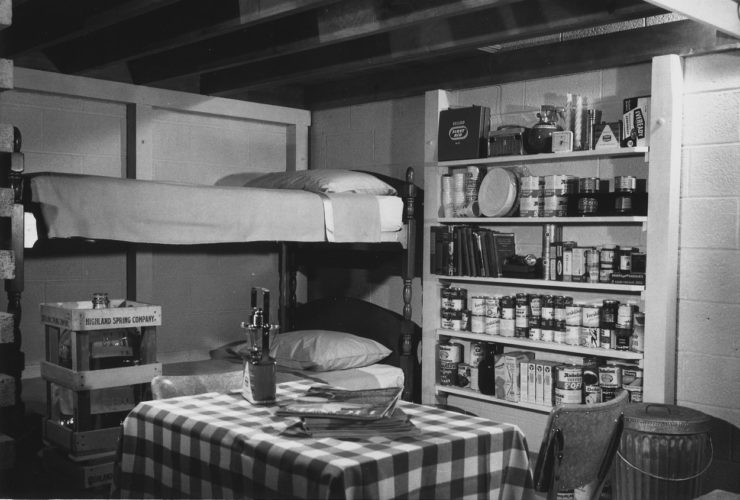Few things are as emblematic of modern society as the nuclear family; nothing is as crucial to the nuclear family as the nuclear fallout shelter. Without a shelter, atomic war may bring swift incineration or painful death from radiation. With a shelter, one can survive with one’s loved ones…at least until the air and food runs out or the radiation finds its way in.
Living as we do in an era of unparalleled international peace and cooperation, fallout shelters might seem a ludicrous expense. During the Cold War, when World War Three seemed a perpetual twenty minutes away, matters were quite different. Many SF authors found fallout shelters inspirational. Here are five examples.
Level 7 by Mordecai Roshwald (1959)
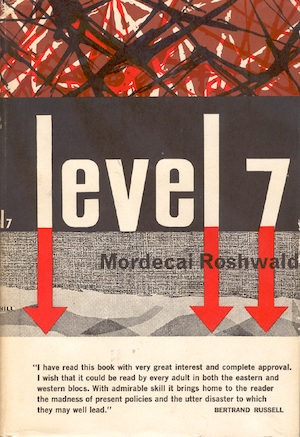
Selected for his obedience, the person known as X-127 immediately obeys orders and launches the initial salvo of humanity’s final war. Two minutes shy of three hours later, the war is over. Humanity has been saved. At least, the humans sharing X-127’s seven-leveled bunker have been saved. Everyone else, it seems, is quite dead.
The seven levels—the upper five occupied by civilians and the bottom two by more important military personnel—should be all that is needed to rebuild civilization once the surface is habitable again. Indeed, one may hope that it is more than sufficient, because levels one through five’s radiation protection turns out to be more aspirational than real. Nevertheless, the lower two levels will assuredly keep the most important people alive… for a good four months.
Roshwald appears to have been rather hostile to the idea of blindly following orders and thus dooming us all. It is not possible to determine if X-127 is a pathetic brainwashed Red, a heroically disciplined American, or something else. It is almost as though the author feels it would be wrong for anyone to obediently end life on Earth.
A Canticle for Leibowitz by Walter M. Miller, Jr.
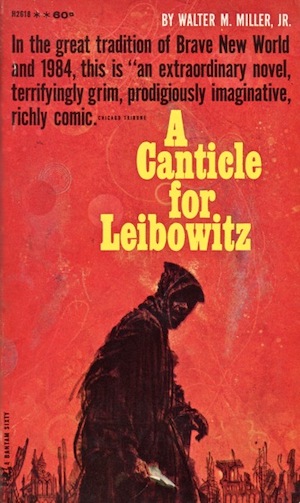
Centuries after the Flame Deluge and the Simplification that followed, the monks of the Albertian Order of Leibowitz preserve what little knowledge survived the disaster. In the time of Brother Francis, the significance of the texts the monks preserve is lost. However, enough knowledge remains that Brother Francis understands the significance of his find, out in the desert…
Beneath desolation lies the remains of structure whose sign declares it to be:
FALLOUT SURVIVAL SHELTER
Maximum Occupancy: 15
The exact nature of fallout is unknown to Francis, although he knows it is a horror that spawned monsters. The shelter appears to have more than served its purpose: thanks to tons of collapsed stone, the inner chamber of the shelter has been sealed since the Flame Deluge. It is the skull outside the shelter that concerns Francis. Could it be the mortal remains of Emily Liebowitz, wife of Sainted Leibowitz, who was thought slain in the Flame Deluge? The skull has a gold tooth as did Emily. For the pious monk, there is no question but that the skull must be Emily’s.
Canticle offers an interesting juxtaposition of the laudable goals of the Brotherhood—preserve knowledge—and the use to which it is once again put. Towards the end of novel, a despairing Dom Zerchi asks himself, “Are we doomed to it, Lord, chained to the pendulum of our own mad clockwork, helpless to halt its swing?”
The answer would appear to be “yes.” Still, A for effort.
Triumph by Philip Wylie (1963)
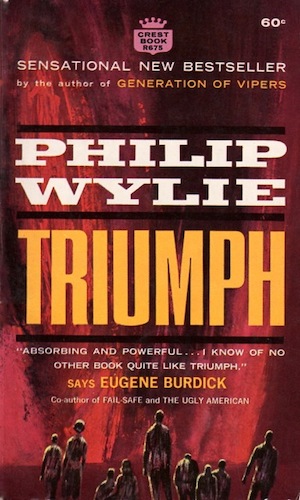
Commies! Bad! Moscow will pay any price to conquer the world. Thus, the Soviets launch an unprovoked attack on the West. The Soviet leadership is well aware that a considerable fraction of the West’s nuclear weapons will survive the attack and be sent on their way towards Eurasia. In fact, the Reds are counting on it. It’s all part of their plan to utterly depopulate the northern hemisphere save for the well-protected Soviet leadership and a small army of loyal minions. When the radiation dies down, the Communists will emerge and conquer the largely untouched southern hemisphere.
Vance Farr had the vision to mandate a shelter of unparalleled quality and the vast fortune sufficient to fund it. Sheltered within, Farr and thirteen extremely lucky Americans are the only people in North America to survive the million roentgen fallout that blankets the continent. What’s not clear is if this is more than a temporary stay of execution: even the years of supplies within the shelter may not allow the survivors to outwait the radiation. It seems unlikely any southern nations would undertake the expense of retrieving a handful of Americans from the lifeless hellscape that is the new America.
A million roentgens is not a typo: the Russians really, really wanted to make sure they got everyone. One of the morals of the story is that no matter how well-prepared a shelter is, it’s not that hard for a determined enemy to ensure it is not well-prepared enough. Shelters will not save America!
I note that Farr’s shelter protects a surprisingly diverse group. I suspect that the author was examining how a representative group of American classes and ethnicities would react to atomigeddon.
Children of the Dust by Louise Lawrence (1985)
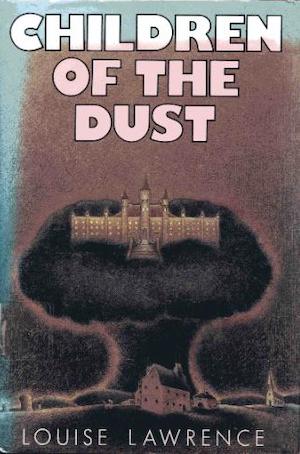
With World War Three swiftly bearing down, the British government provides its citizens with cheerfully optimistic advice while constructing impressive, well-stocked, well-sealed bunkers for the people who actually matter. As soon as the balloon goes up, Britain’s leaders and that lucky few who will serve them retreat into safety.
Sarah, her stepmother Veronica, and Sarah’s siblings William and Catherine did not qualify for admission into the secure facility. They do have sufficient distance from targets to avoid immediate incineration, helpful government pamphlets, and an entire household of materials to repurpose into an ad hoc shelter. The results are a tribute to British pluck and ingenuity. If only they’d remembered to seal the chimney…
I imagine that over in Sussex, Jim Bloggs and his wife followed the very same government leaflets to much the same effect. For some reason, British authors didn’t seem bullish about surviving WWIII. Readers outraged at the actions of the government may be assured that while it takes some time, the people in the bunkers do eventually get their just deserts.
Paranoia by Greg Costikyan, Dan Gelber, and Eric Goldberg (1984)
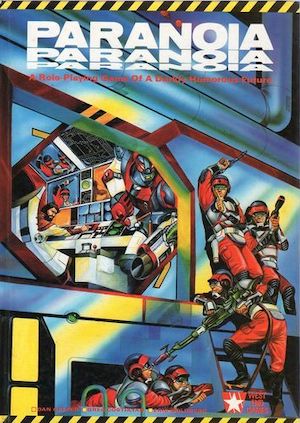
Although the nature of the calamity that threatened Alpha Complex in the backstory to this venerable tabletop roleplaying game has been lost to time, it cannot be denied that Alpha Complex succeeded in protecting its inhabitants from whatever it was, if it even existed. This is not merely because Friend Computer would order your immediate liquidation for doubting it. The population within Alpha Complex are provided with everything they could desire. Just ask Friend Computer. Remember to put your affairs in order first.
Threatening this utopian state of affairs are the Commie Mutant Traitors! Players are tasked with the job of hunting down and eliminating these undesirables. It is too bad that the Computer, having long ago forgotten what a Commie is, has adopted a very inclusive definition. Worse, every player is both a mutant and a member of a secret society, therefore by definition a traitor. Long-term survival is unlikely. Good thing each character comes with multiple clones.
Among the many luminaries who contributed to the Paranoia game line was the late John M. Ford. Ford’s Paranoia module The Yellow Clearance Black Box Blues inspired players to scream in glee and player characters to just scream.
***
The works above represent a very small sample of a very large field. Nuclear war fiction abounds with veritable freeholds protecting their inhabitants from the aftereffects of nuclear war. Feel free to extol the virtues of your unmentioned favourites in the comments, which are, as ever, below.
In the words of fanfiction author Musty181, four-time Hugo finalist, prolific book reviewer, and perennial Darwin Award nominee James Davis Nicoll “looks like a default mii with glasses.” His work has appeared in Interzone, Publishers Weekly and Romantic Times as well as on his own websites, James Nicoll Reviews (where he is assisted by editor Karen Lofstrom and web person Adrienne L. Travis) and the 2021 and 2022 Aurora Award finalist Young People Read Old SFF (where he is assisted by web person Adrienne L. Travis). His Patreon can be found here.










